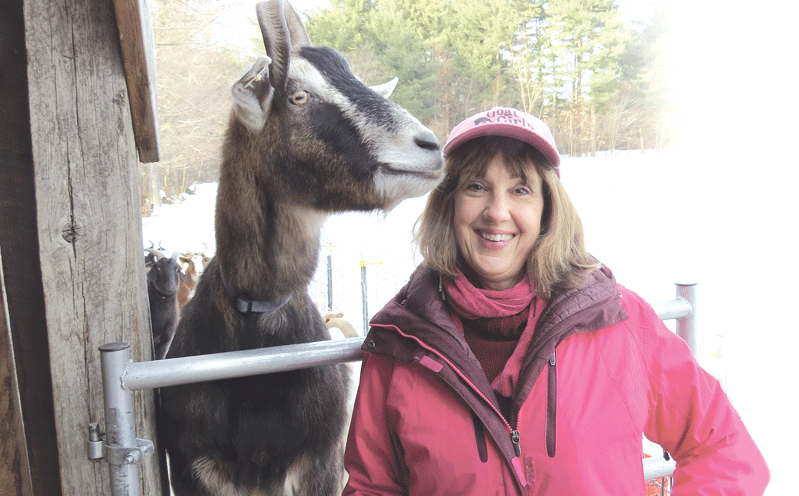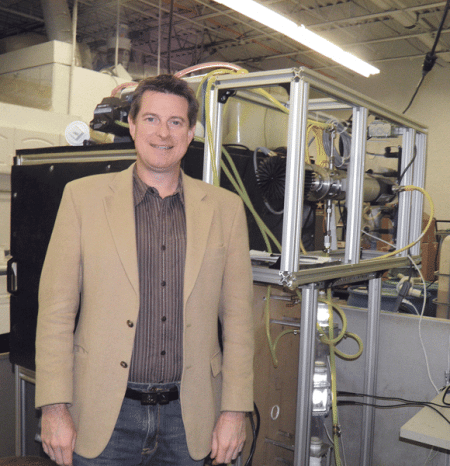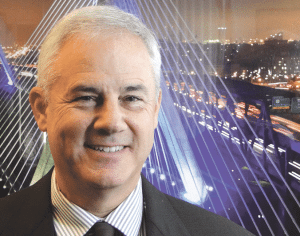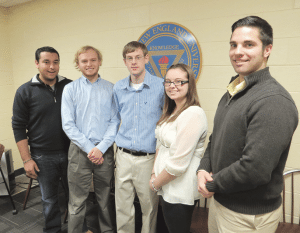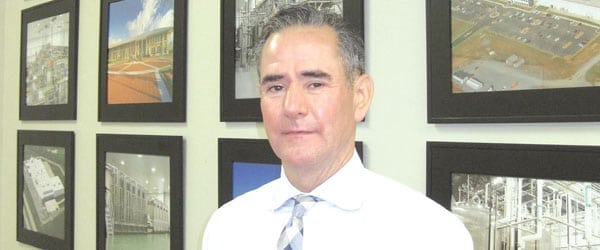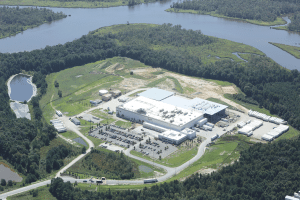Sustaining Success

From its inception in 1976, the Center for EcoTechnology has always responded to the needs of businesses when it comes to being more energy-efficient and reducing waste. But in many ways, the nonprofit has also been an innovator, introducing green-business concepts years before they would be considered mainstream. At a time when energy supply and climate change remain serious concerns, CET’s leaders believe the pace of change in this field will be even more intense over the next 40 years — and they’re helping to raise the next generation to meet those challenges.
In many ways, the 1970s was the birth of the modern environmental movement. The decade saw the first Earth Day, the creation of the Environmental Protection Agency, and legislation in the form of the Clean Air Act, the Clean Water Act, and the National Energy Act.
And, of course, it was the decade when Americans wondered when they would run out of gas.
“We were a reaction to the oil crisis of the ’70s,” said John Majercak, president of the Center for Ecotechnology (CET), the Northampton-based nonprofit celebrating its 40th anniversary this year. “Everyone was worried about energy security.”
Instead of just fretting over this new normal, CET’s founders had an idea: to examine technologies and practices that could improve energy efficiency for businesses and reduce their environmental impact, all while increasing profits and raising quality of life.

John Majercak
“We started in the time of the oil embargo, and dependence on foreign oil was a major concern,” said Associate Director Nancy Nylen, who has been with CET since 1982. “There were environmental concerns as well, but this was before the conversation about climate change. Yet, the solutions were very similar. From the start, we were finding an intersection between what’s helpful for the environment and what’s practical and affordable so it can be adopted.”
At first, CET focused on energy conservation, in particular partnering with utility companies on the relatively new concept of ‘energy audits,’ whereby a consultant visits a home or business to talk about ways in which their building or operation could be revamped to save on energy costs.
“We were right on the cusp of that happening across the country,” Nylen said. “In Massachusetts, CET was really the one that got that started, the concept of going through a building and assessing opportunities for reducing energy and identifying waste. That was a new concept, and it was educational for the people; they really appreciated it. I run into people who remember us coming into their building 30 years ago.”
Other early initiatives included the development of a passive solar greenhouse at Berkshire Botanical Garden and Project SUEDE, a program that taught solar energy, energy-conservation theory, and carpentry to unemployed people, who then installed 31 solar space-heating systems in low-income households.
“We were looking to help people and businesses reduce their reliance on fossil fuels, and right from the start we were providing this information in a technical-assistance role and through one-on-one workshops and information sessions,” Nylen told BusinessWest. “We were much smaller then — four people, just a tiny organization working on a couple of programs.”
Go HERE for a chart of Environmental Services in the region
CET still conducts energy audits, helping homeowners and businesses understand the value of sustainable systems and educating them on the incentives available to make changes. But the organization, which now employs some 75 people, has become much more, expanding its mission into a host of new opportunities, from composting and food-waste reduction to recycling building materials through its EcoBuilding Bargains store in Springfield, just to name a few.
“If you look at what’s happened over the past 40 years, the pace of change has really accelerated; the whole environmental space has blown up,” Majercak said. “It’s really exciting and creates a ton of opportunities. It also means we have to keep on our toes to make sure we’re working in areas of the most need. Looking at the next 40 years, the pace of change will be even faster.”
For this issue’s focus on environment and engineering, BusinessWest visits with the leaders of a nonprofit that has been a leader, innovator, and model for the growing green-business industry, and how they expect their work to continue to evolve.
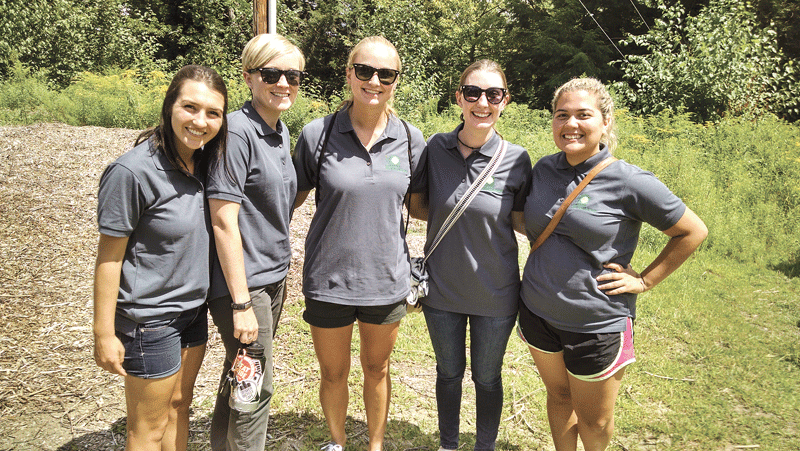
From left, Claire Cuozzo, Brittney Topel, Kelsey Colpitts, Coryanne Mansell, and Diana Vazquez, the 2015-16 cohort of CET’s fellowship program, spent 10 months gaining experience to help them prepare for a career in the environmental field.
Dollars and Sense
CET has long used the slogan “we make green make sense,” stressing the intersections between environmental awareness, good business sense, and positive community impact. That goal has always been shaped in part by events outside the Commonwealth.
Take the ‘garbage barge’ of 1987, the vessel that carried 3,168 tons of New York trash — originally headed for a methane-production project in North Carolina but then rejected by that state’s officials — along the Atlantic coast and Gulf of Mexico, with no place to land.
“With the garbage barge, waste management and recycling became a huge issue,” Majercak said. “It galvanized the media and policy makers and organizations like CET, who started saying, ‘let’s do something about it.’ We worked to get the first recycling bylaws in the city of Springfield, and we helped towns and residents set up their first recycling programs. We also started working with businesses around recycling.”
Those efforts have grown significantly over the years, including a program — funded by the state Department of Environmental Protection — called RecyclingWorks in Massachusetts, through which CET offers technical advice and assistance to companies regarding recycling and composting waste.
“We’ve worked with hundreds and hundreds of businesses across Massachusetts,” he said. “We help them set up or improve their recycling or composting programs.”
That work is more important after the state passed a law in 2014 limiting the amount of food waste businesses may dispose of. “We’ve done some award-winning work in Massachusetts in places like Big Y, Whole Foods, and Stop & Shop, as well as lots and lots of restaurants and food manufacturers,” Majercak said. “We’re now doing similar work in Connecticut and looking to take it across New England.”
Nylen referred to such efforts as “innovating and mainstreaming,” the effort to identify the next big need or trend in green business and help popularize it. For Lorenzo Macaluso, it’s more about showing companies how such practices benefit them and their customers.
“For businesses, we’re really adept at understanding their needs and adapting opportunities for them, and then being a neutral solutions finder for them, whether we’re talking about recycling, composting, or energy-efficiency work,” said Macaluso, CET’s director of Green Business Services. “We’re not there to sell them on a product — we’re not going to install a specific type of boiler; we’re not going to compost the food waste ourselves. What we will do is say, ‘here are your options, here are the business implications, the costs, and the incentives.’”
In doing so, CET has worked with companies ranging from small shops to large entities like Big Y and Titeflex.

Nancy Nylen says CET was born from a desire to help people reduce their reliance on fossil fuels, and that goal is still a driving force today.
“We’ve been working with Big Y for over 20 years, way before it was cool,” Macaluso said. “They’re now recycling and composting at all their stores in Massachusetts and Connecticut, and when you factor in the avoided costs of trash disposal and a little bit of revenue from the materials they’re recycling, it’s like a $3 million annual boost to the bottom line. For them, that’s a big deal. They’re also able to take that information about their savings — how they’re not throwing things into the trash, how much greenhouse gas they’re saving — and share it with their customers.”
That public-information aspect is important for many CET clients, who recognize the popularity of green practices in what has long been a very progressive region. “They want to share the good work of what they’re doing. They can use that to market themselves, or just market internally, sharing the information with their employees.”
The bottom line benefits in other ways as well, Macaluso added. Insulation upgrades, air-quality improvements, and other efforts can also improve employee comfort, which in turn helps with productivity.
“Green business is now half of what we do. There’s so much potential in the commercial space,” Majercak said. “It’s a benefit to their business, and something their customers and shareholders expect. This whole world of greening your business has become pretty much mainstream. Not every business is going green, but the idea that it should happen is pretty well accepted.”
Second Life
Another success story at CET has been EcoBuilding Bargains, which began life as the ReStore in 2001 before undergoing a move and rebranding five years ago.
In its first incarnation on Albany Street in Springfield, the ReStore dealt in recycled building materials, aiming to save builders and do-it-yourselfers money while reducing the burden on landfills. A move to Warwick Street in 2011 involved a $900,000 energy retrofit on the existing building on that site — an example of CET practicing what it preached.
Those improvements began on the exterior of the building, including a white roof to deflect heat, and insulated panels lining the building that interlock in a way that seals out all air leakage. EcoBuilding Bargains also ‘superinsulated’ its roof, using insulation donated from MassMutual when that company installed a solar array on its roof.
In addition, the 3 million-BTU, oil-fired boiler in the basement was replaced with a 500,000-BTU gas unit, while infrared tube heaters located throughout the structure heat building occupants but not the air. The efficiency extends to lighting as well; much of the store features sensor-controlled lights that maintain a low level when no one is around them, but become brighter when someone walks in.
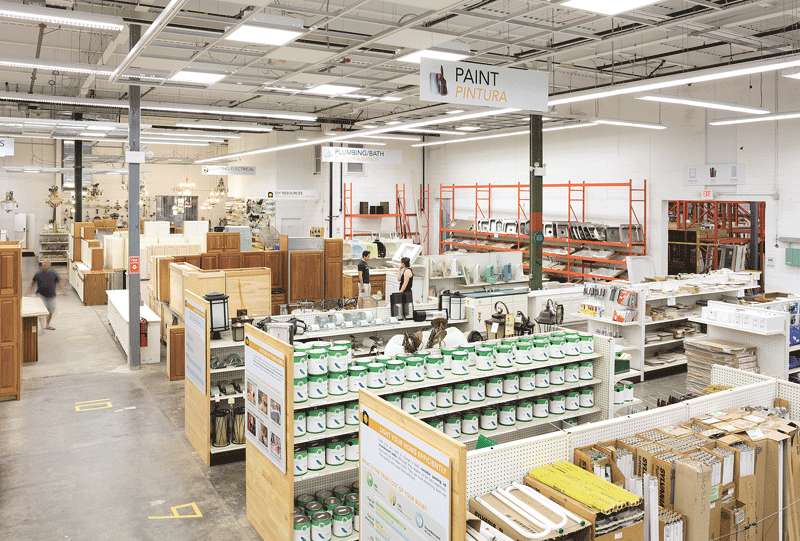 Most importantly, though, EcoBuilding Bargains has met an ambitious goal set when it moved, doubling the amount of materials it recycles (and keeps out of landfills). Over the next couple of years, it will seek to increase that figure by another 50%.
Most importantly, though, EcoBuilding Bargains has met an ambitious goal set when it moved, doubling the amount of materials it recycles (and keeps out of landfills). Over the next couple of years, it will seek to increase that figure by another 50%.
“There’s a lot of opportunity — lots of stuff being thrown away, a lot of people on a budget who want to fix their homes affordably,” Majercak said. “What’s different now is that reuse is becoming trendy. This new generation of homeowners in their 20s and 30s really like this style of ‘upcycling’ and believe in the mission of upcycling. So we’re getting the bargain-hunting, weekend-warrior type of shopper, but also the mission-style shopper, too.”
CET has also found success in its Go Green Campaign, a three-year effort (2014-16) to help 80,000 people take green actions, reduce energy usage equivalent to taking 40,000 homes off the grid, lowering carbon emissions equivalent to taking 100,000 cars off the road, and creating $100 million in lifetime energy and waste savings for residents and business owners.
“A number of years ago, we decided to focus on measurable impact, to see if we’re doing a good job or not, and also to get people excited about working with us,” Majercak told BusinessWest. “We’ll meet or exceed all these goals by the end of the year. People say, ‘does it really make a difference if I start up a recycling program or change the lights in my house?’ Yes, it adds up over time; it makes a huge difference. And we’ll have new goals at the end of the year.”
These numbers are important because demonstrating impact is the most effective way to build public support for CET’s work, he went on. “They want to know we’re making good investments, and this is one way we can make the case to the community that supports us.”
The center is also making an effort to raise up the next generation of green innovators, through a fellowship program it launched five years ago. Five fellows per year — recent college graduates from across the U.S. — are chosen to work with CET for one year and receive training in environmental science, energy efficiency, waste reduction, and other aspects of green business. They’ve gone on to work at similarly minded nonprofits, and also corporations looking to go green.
“We see it as a way to develop tomorrow’s leaders. This generation is actually going to be responsible for how we deal with climate change,” Majercak said. “They’re super-bright, super-motivated, and when you interact with them, it gives you hope for the future. It’s a very exciting program.”
Nylen agreed. “We started with them doing primarily education and outreach. But it became clear they were really interested in different aspects of what we were doing at CET, helping with green businesses, helping with EcoBuildingBargains,” she said. “We saw it as a way to bring a new set of eyes to our work and be a training ground for new leaders. It’s been quite rewarding.”
Greener Landscape
Majercak is gratified when he surveys the business landscape in Massachusetts and recognizes how ingrained environmental concerns and energy efficiency have become in the Bay State, in industries ranging from architecture and construction to healthcare and food service.
“We love working here. We’re very fortunate to be where we are, with the amount of community support we get and the participation in the things we offer,” he said. “It’s a really phenomenal business community here in the Valley and Western Mass., and Massachusetts and New England in general — very forward-thinking and supportive of our work and very actively engaged, and that’s important because organizations like us need to show it’s possible so our work can be replicated elsewhere. And that’s certainly happening; people call from all over the country.”
Nylen agreed. “We’ve been in an environment in Massachusetts where policy has been beneficial to promoting energy efficiency, and we help bring that to different target audiences, whether homeowners or businesses.”
Majercak knows there’s plenty left to do. For one thing, the next 20 to 30 years will likely see more building retrofitting than new construction. Then there’s the looming threat of climate change, which, if the direst models come to pass, will force everyone to move more quickly toward more sustainable practices.
“If we want to be in a place where we have a low-carbon or no-carbon economy, that’s going to take a lot of work, a lot of innovation,” he said. “It’s going to take not just technology or policy, but getting it to work in the marketplace, getting people to actually practice the behavior, get businesses to make the change.
“It doesn’t matter whether you believe in climate change, or care,” he added. “Everyone knows that wasting energy is not a good thing. Businesses care about the bottom line. Homeowners don’t want to spend too much money. We do a lot of work educating the public on what the benefits are.”
The changing needs of businesses when it comes to green practices lends Nylen’s work a certain freshness, even after 34 years with CET.
“I feel fortunate to do this work as my profession, and to work on each of our new initiatives as they come along. That’s kept me really interested,” she said.
“I’ve always felt we were relevant, but it seems the work we do now is more urgent than ever before,” she added. “Whether we’re reducing costs, reducing waste, or reducing impact on the environment, we can usually find something that addresses what people are interested in. We meet people where they are.”
Joseph Bednar can be reached at [email protected]




